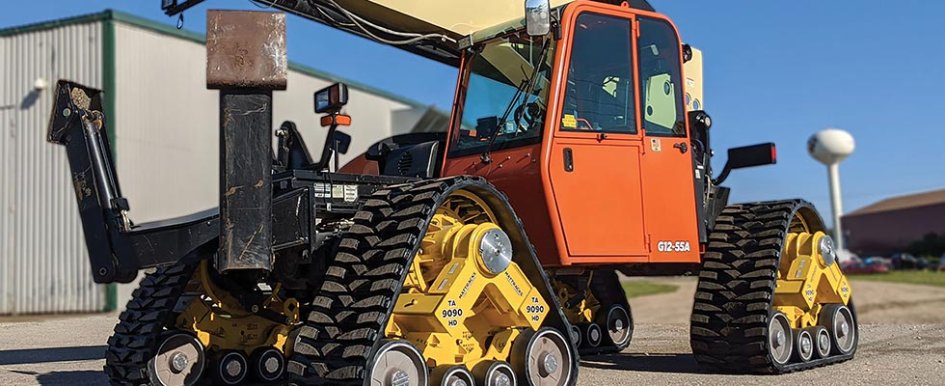
Rubber track conversions are gaining popularity as an easy-to-install solution for commercial construction and other types of businesses that frequently need to travel over rugged and unpredictable terrain. Built initially for lighter-duty trucks, advancements in rubber track conversion systems are now a smart option for contractors and construction companies that are driven to complete projects on time.
As compared to expensive alternatives like building temporary haul roads, rubber track conversions are available for most any kind of heavy-duty industrial or commercial truck or specialized vehicle. With tracks versus tires, large service rigs — such as those used in the energy, mining, military and construction industries — can easily traverse through softer surfaces like mud and snow.
The oil and gas industry was one of the first to turn toward truck tracks. Over the past 10-15 years, many others have followed. Companies have listened to the specific needs of large equipment operators and have successfully engineered commercial-quality track conversion systems.
When it comes to tracks versus tires for heavy-duty trucks, here’s a short list to share with the decision-makers in your organization.
1. Traction
Rain, mud and snow are no excuse when you have tracks on your trucks. When it’s a business at stake, operators need to find a way to gain traction to move heavy vehicles through sloppy conditions. Tracks provide more transfer torque to the ground, greater traction and increased flotation. As a result, the ground pressure and environmental footprint is reduced.
2. Cost-Efficient
Most track customers agree that the return on investment (ROI) of a track conversion system will most often outweigh the cost of building temporary haul roads. Or worse yet, the expense of having to hire massive machines or helicopters to come in and drag vehicles out of mud, snow or sand. At the same time, construction and industrial operators avoid losing the tens of thousands of dollars it can cost for each down day due to weather delays.
3. Versatile
Commercial-level rubber track conversions are designed not only for soft, wet terrain but also for higher speeds on the roadways when traveling from home base to each worksite. Track manufacturers know that speed and efficiency matter regardless of the vehicle size and weight. Also, the track conversions can be easily switched over to another vehicle in the fleet, if needed.
4. Durable
Advancements in track design have increased durability, efficiency and even tolerance for speed. Today’s rubber track conversion systems are designed to carry the weight of Class 7 or 8 heavy-duty trucks as well as specialized equipment. Higher-end track conversion manufacturers have a broad range of options with high-end systems engineered to handle up to 80,000 pounds.
5. Specialized
Besides heavy and extra heavy-duty trucks, track conversion systems are also available — either standard or custom — for specialized equipment such as aerial lifts, telehandlers, autonomous vehicles, fire trucks and many others. Depending upon the industry’s specific needs and/or the challenges of a certain project or region, track conversions can be an ideal way to solve a specific mobility problem.
6. Safe
The last, but not least, reason for tracks in construction is safety. Rubber track conversions from a proven industry leader and experienced manufacturer will likely have a track record in safety. A track maker with a history of no injuries or deaths is an important consideration due the wide range in what is considered safe for dangerous jobs. Tracks for heavy-duty work trucks need to be made with the best available materials and designed specifically for each vehicle in the fleet.
The bottom line is that rubber track conversions are one important way your construction projects can safely and efficiently stay on track regardless of challenges related to terrain or bad weather. What matters most is the well-being and productivity of your crew. The most critical factor in achieving this is the quality, durability and versatility of your equipment fleet. With track conversion systems, operators will surely work more hours, accomplish more, and prevent disasters, delays and emergency situations.
Regardless of the specific application, industry, equipment or unique challenges related to the completion of short or long-term projects, rubber track conversions are one good way to stay on course. Contractors, owners and operators know that in today’s high-pressure work environment, it’s crucial to remove any controllable obstacles and keep moving forward as quickly and efficiently as possible.
